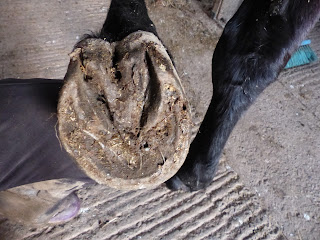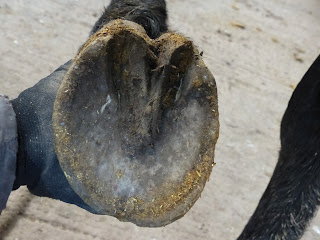I received an incredible email this morning. I could hardly ask for a better start to the week and it was so heartfelt that I asked the writer's permission straightaway to share it here. Luckily she said yes!
Dear Nic,
You don't know this, but you saved my horse. I am eternally grateful for this. I have actually owed you this email for three years, but I have been too busy riding my horse to write.
I am an American living in Germany. In the spring of 2015, six months after I bought my first horse, I let a friend ride him in a local small jumping tournament. He is a 172 cm Holsteiner with a long record of successful jumping tournaments around Germany. At the time, I was recovering from carpel tunnel surgery and he was trained as an advanced-level jumper. They had been jumping together while I was in surgery and so it seemed perfectly harmless.
Late April, three days before the event she and the farrier insisted my horse needed studs on his front shoes and that he needed back shoes too -- he was very footy and was ridden out too often on the roads. His feet were going to wear away. At the time I trusted them both and agreed to the shoes. At the time, I had no idea the impact the spring grass had on him or the fallacy of this statement.
The tournament was a big mistake. He came badly over the second tournament jump. The rider came off and dangled from his neck as he galloped on. It was an ugly mess. The next day, it was clear, he had sustained a shoulder injury in the event. It was hot, swollen, tender to the touch. He was lame and miserable.
When he was taken to the clinic for an examination the vet said immediately, that horse's don't get shoulder injuries without hoof problems. He x-rayed his hoofs and found channels on the navicular bone. The vet declared the prognosis grim. He would never be well enough to ride again. At all. He recommended, politely, I get a new horse. This one was finished.
Deep in shock, I did what anyone would do: I started Googling navicular. I was immediately surprised to find Rockley Farm and another rehabilitation center (Strasser). It didn't make much sense to me, if it was really a hopeless disease. My childhood friend had Muscular Dystrophy. It is, without a doubt, a degenerative disease. There is no rehab available. Her doctors also said she wouldn't live past age six, but they were wrong. She just turned 45, last month. So, I know there is hope in hopeless situations. So I read. I ordered your book and every other one I could find. I looked at navicular studies and dug down to the raw data. It was all a bit confusing and contradictory. Yet, there was enough grey area for me to be optimistic that my horse could be rehabilitated and go on to lead a quality life.

The Rockley Farm barefoot rehabilitation approach seemed like the simplest idea with no harsh side effects and I was convinced the transition might slow him down enough to allow his shoulder to heal. With his shoulder inflamed, I certainly wasn't looking for a quick fix. My horse had always struggled to keep shoes on, anyway. They were constantly being lost. He had stocked-up over the winter when he had no turnout. And, I was suspicious of the roll the studs played in his injury. So, I was pretty certain, all the wedge-style rehabilitation shoes were not going to work for him.
Unfortunately, I didn't have the means to send him to Rockley, so I was left to help him sort it out myself at the stable. I am so grateful that you share so much of what you do. How to feed, how to look at the landings, and the importance of movement, etc.. I decided to build a small team of people to help me. Needless to say, when I approached my farrier with this barefoot rehab team idea, it did not go well. I got him to take my horse's shoes off and then I was ostracized for being an idiot.
Still, I soldiered on. I hired a nutritionist to help me with the feed options in Germany and a physio to help with the shoulder. I read Feet First over and over again like a Bible. Several weeks in, it was becoming evident, I had a horse like your Bailey on my hands (he is a grey also, coincidentally). My horse suddenly had signs of metabolism issues (neck and bum fat deposits, clumpy coat, blackened soles, etc.). He was extremely grass sensitive. His immune system was out of whack -- he was catching everything -- mud fever, sweet itch, etc. Everyone thought I was crazy spending time and money on this horse, but, I kept going because I could seem him responding to his new diet and new way of going. His feet were changing everyday. They had a pronounced line where his hooves were growing in a completely new angle. His frogs were growing. He had even started to show signs of growing a deviation on the hoof with the shoulder injury. More than anything, I saw his character change. He seemed more content, more relaxed. He seemed relieved to have the shoes off, even though he was only moving slowly around.
About 13-14 weeks in, his shoulder seemed better. He let me saddle him up, get on, and walk around in the arena. He was on the mend. A few days later, another farrier came and I thought it would be okay if the farrier did a little trim--you know-- just to clean things up. What a disaster!
After the trim, his feet looked absolutely lovely, but I was hurled back to square one immediately. His shoulder was hot, swollen, tender to the touch. He was incredibly footy (no surprise since the farrier cut his frogs back so much they looked atrophied) . All his issues and sensitivities came roaring back. He was miserable. I was miserable. Once again, it took months for him to grow his deviation back, to grow his frogs back and back of the hoof to strengthen and thereby allowing his shoulder to come back to the healing processes.
If it was not for your blog and your books and your celery concept, I would have thought that he could not be barefoot. That he would never heal. And, after that trim, I would have thought all the naysayers were right, it was a hopeless. The setback was so profound. But I kept going.
Through it all I tweaked the food and the minerals trying to find that balance he needed. I was close, but he was still just a bit off. I finally broke down and had the stable's grass, hay, and haylage tested. That solved a huge piece of the puzzle, of course. In a short time of better matching, it came together. The metabolism issues are gone, he is rarely, if ever, footy (and if he is...we just limit grass time and his is back on track), his skin and coat are gorgeous. And, he is deeply happy. It is easy to see.
Each year he has gotten stronger and his hoofs have developed more. One of the things I like about having my horse barefoot is the near instant feedback. If something disagrees with him, I know it within a day or two. There are no shoes masking how he is really coping. Since I stopped letting farriers shape his hooves the way they see fit and allow my horse to keep his feet the way he needs them, he is back to being a fast and powerful horse. He hasn't been lame a single day in YEARS. The last time was in 2016 when I let a barefoot trimmer take a smidgen off (I like to mistakes more than once). It wasn't what he needed. He was lame for a month. After that I promised it would never happen again. And it hasn't. He keeps one foot especially ugly - it nearly always has some kind of crack or chipping and he maintains a weird deviation on both sides. I wish it would look better, but it doesn't. It's the hoof under the old shoulder injury. The other three are usually very tidy, but sometimes not. I have finally stopped caring what anyone thinks. How my horse goes and what he tells me is all that matters.
Back in the spring of 2017, I finally was brave enough to let him jump again. I am not bold enough for jumping (dressage and some hacking are it for me) so I let one of the teenage eventers at the stable take him out for a spin. Needless to say, he went without hesitation. He was absolutely and completely back in form. He seemed delighted with himself and ready to jump a full circuit. It was a great moment.

Pretty much since the fall of 2016, he has been ridden 4-6 days a week. At his last check up, my new vet desperately tried to find him lame. He x-rayed his hooves again. He had me trot him up the gravel drive. Then trot up the paved road. He floated both times. The vet looked at his ugly feet and asked when he had last been trimmed. His face was priceless when I said, nearly three years ago. He was dumbfounded, especially since he could see those channels on his navicular bone were exactly the same as the original x-ray. I also admitted I ride him on the paved roads regularly and let him free jump in the arena from time-to-time. He was shocked. It was all --unorthodox. He then asked me exactly what I had been feeding and doing with him because he was healthier than many of the horses he sees that are half his age. By the end of the visit, he couldn't deny the health of my horse and told me to keep doing what I was doing -- including not trimming. It is clearly working.
Thank you for sharing so much information about Rockley Farm and its rehab. Thank you for sharing all the ugly pictures of hooves in transition. Thank you for sharing pictures of healthy hardworking hooves. Especially the wonky ones. Thank you for sharing the importance of movement and proper landing and how to spot it. Thank you for sharing everything. It absolutely changed my life and, more importantly, my horse's life.
Sincerely,
Mary





















































